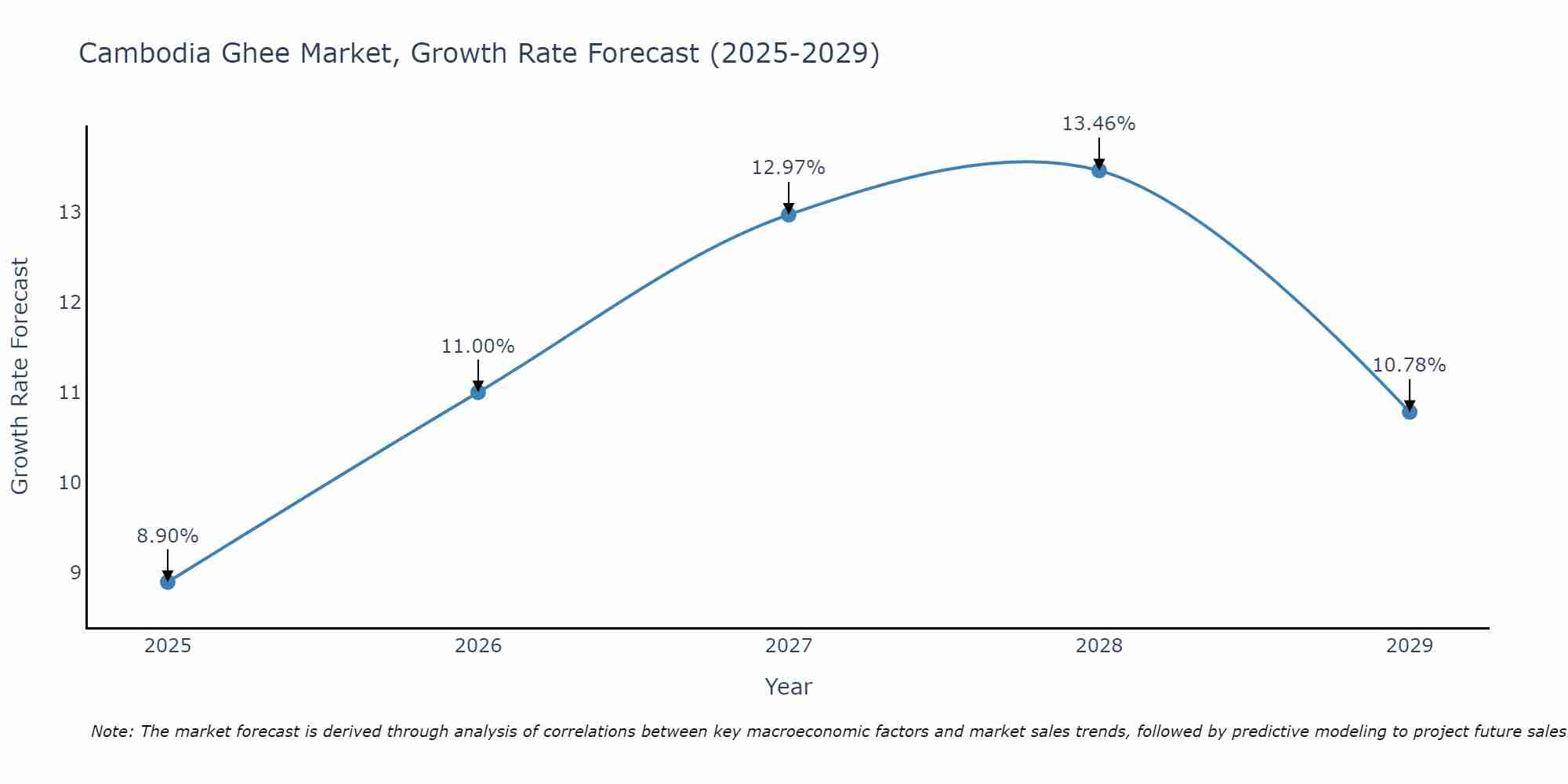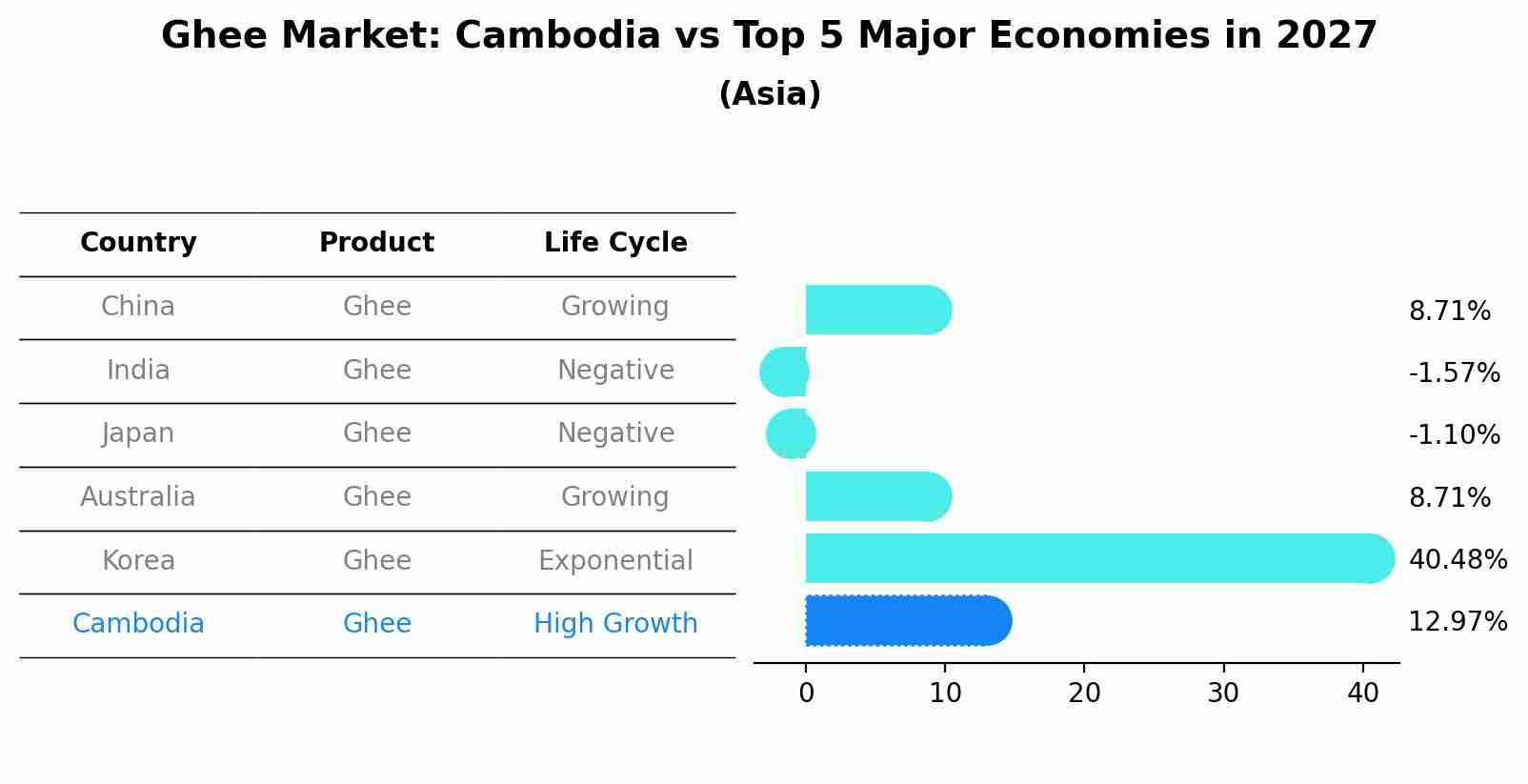Cambodia Ghee Market (2025-2031) Outlook | Companies, Forecast, Analysis, Value, Revenue, Trends, Share, Industry, Growth, Size
| Product Code: ETC187845 | Publication Date: May 2022 | Updated Date: Aug 2025 | Product Type: Market Research Report | |
| Publisher: 6Wresearch | Author: Ravi Bhandari | No. of Pages: 60 | No. of Figures: 40 | No. of Tables: 7 |
Cambodia Ghee Market Size Growth Rate
The Cambodia Ghee Market is projected to witness mixed growth rate patterns during 2025 to 2029. Starting at 8.90% in 2025, the market peaks at 13.46% in 2028, and settles at 10.78% by 2029.

Ghee Market: Cambodia vs Top 5 Major Economies in 2027 (Asia)
By 2027, the Ghee market in Cambodia is anticipated to reach a growth rate of 12.97%, as part of an increasingly competitive Asia region, where China remains at the forefront, supported by India, Japan, Australia and South Korea, driving innovations and market adoption across sectors.

Cambodia Ghee Market Overview
The Cambodia Ghee Market serves the food and culinary industry`s demand for clarified butter products with a rich aroma, nutty flavor, and high smoke point for cooking, baking, and flavoring applications. Ghee, made from simmering butter to remove water and milk solids, offers a versatile cooking fat suitable for frying, sautéing, and seasoning various dishes in Cambodian cuisine. With the growing popularity of traditional cooking methods, gourmet cuisine, and ethnic foods in Cambodia, the consumption of ghee is increasing, driven by factors such as culinary heritage, taste preferences, and the nutritional benefits of clarified butter in cooking and food preparation.
Drivers of the market
Ghee, a clarified butter widely used in cooking and traditional medicine, holds cultural significance and nutritional value in Cambodia. The ghee market is driven by factors such as population growth, urbanization, and the popularity of traditional cuisines, contributing to the demand for high-quality dairy products and cooking fats in the market.
Challenges of the market
Challenges in the ghee market include addressing concerns related to consumer preferences and competition from alternative cooking oils. Ensuring product quality and promoting the nutritional benefits of ghee pose challenges for manufacturers in Cambodia. Moreover, addressing affordability constraints and market saturation could impact market growth.
Government Policy of the market
The Cambodian government has implemented policies aimed at ensuring the quality and safety of ghee products in the market. Regulatory bodies oversee the production processes, setting standards for hygiene, packaging, and labeling. Additionally, there are measures in place to monitor imports and ensure compliance with national food safety regulations.
Key Highlights of the Report:
- Cambodia Ghee Market Outlook
- Market Size of Cambodia Ghee Market, 2024
- Forecast of Cambodia Ghee Market, 2031
- Historical Data and Forecast of Cambodia Ghee Revenues & Volume for the Period 2021-2031
- Cambodia Ghee Market Trend Evolution
- Cambodia Ghee Market Drivers and Challenges
- Cambodia Ghee Price Trends
- Cambodia Ghee Porter's Five Forces
- Cambodia Ghee Industry Life Cycle
- Historical Data and Forecast of Cambodia Ghee Market Revenues & Volume By Source for the Period 2021-2031
- Historical Data and Forecast of Cambodia Ghee Market Revenues & Volume By Cow for the Period 2021-2031
- Historical Data and Forecast of Cambodia Ghee Market Revenues & Volume By Buffalo for the Period 2021-2031
- Historical Data and Forecast of Cambodia Ghee Market Revenues & Volume By Mixed for the Period 2021-2031
- Historical Data and Forecast of Cambodia Ghee Market Revenues & Volume By End-use for the Period 2021-2031
- Historical Data and Forecast of Cambodia Ghee Market Revenues & Volume By Retail for the Period 2021-2031
- Historical Data and Forecast of Cambodia Ghee Market Revenues & Volume By Institutional for the Period 2021-2031
- Historical Data and Forecast of Cambodia Ghee Market Revenues & Volume By Distribution Channel for the Period 2021-2031
- Historical Data and Forecast of Cambodia Ghee Market Revenues & Volume By Supermarkets/Hypermarkets for the Period 2021-2031
- Historical Data and Forecast of Cambodia Ghee Market Revenues & Volume By Convenience Stores for the Period 2021-2031
- Historical Data and Forecast of Cambodia Ghee Market Revenues & Volume By Specialty Stores for the Period 2021-2031
- Historical Data and Forecast of Cambodia Ghee Market Revenues & Volume By Online for the Period 2021-2031
- Historical Data and Forecast of Cambodia Ghee Market Revenues & Volume By Others for the Period 2021-2031
- Cambodia Ghee Import Export Trade Statistics
- Market Opportunity Assessment By Source
- Market Opportunity Assessment By End-use
- Market Opportunity Assessment By Distribution Channel
- Cambodia Ghee Top Companies Market Share
- Cambodia Ghee Competitive Benchmarking By Technical and Operational Parameters
- Cambodia Ghee Company Profiles
- Cambodia Ghee Key Strategic Recommendations
Frequently Asked Questions About the Market Study (FAQs):
1 Executive Summary |
2 Introduction |
2.1 Key Highlights of the Report |
2.2 Report Description |
2.3 Market Scope & Segmentation |
2.4 Research Methodology |
2.5 Assumptions |
3 Cambodia Ghee Market Overview |
3.1 Cambodia Country Macro Economic Indicators |
3.2 Cambodia Ghee Market Revenues & Volume, 2021 & 2031F |
3.3 Cambodia Ghee Market - Industry Life Cycle |
3.4 Cambodia Ghee Market - Porter's Five Forces |
3.5 Cambodia Ghee Market Revenues & Volume Share, By Source, 2021 & 2031F |
3.6 Cambodia Ghee Market Revenues & Volume Share, By End-use, 2021 & 2031F |
3.7 Cambodia Ghee Market Revenues & Volume Share, By Distribution Channel, 2021 & 2031F |
4 Cambodia Ghee Market Dynamics |
4.1 Impact Analysis |
4.2 Market Drivers |
4.2.1 Increasing health consciousness among consumers leading to a shift towards natural and organic food products. |
4.2.2 Growth in disposable income and changing lifestyles driving demand for convenience foods like ghee. |
4.2.3 Rising awareness about the health benefits of ghee among consumers. |
4.3 Market Restraints |
4.3.1 Fluctuating prices of raw materials like milk impacting the production cost of ghee. |
4.3.2 Competition from substitute products like butter and margarine affecting market penetration. |
4.3.3 Regulatory challenges related to quality standards and food safety regulations. |
5 Cambodia Ghee Market Trends |
6 Cambodia Ghee Market, By Types |
6.1 Cambodia Ghee Market, By Source |
6.1.1 Overview and Analysis |
6.1.2 Cambodia Ghee Market Revenues & Volume, By Source, 2021-2031F |
6.1.3 Cambodia Ghee Market Revenues & Volume, By Cow, 2021-2031F |
6.1.4 Cambodia Ghee Market Revenues & Volume, By Buffalo, 2021-2031F |
6.1.5 Cambodia Ghee Market Revenues & Volume, By Mixed, 2021-2031F |
6.2 Cambodia Ghee Market, By End-use |
6.2.1 Overview and Analysis |
6.2.2 Cambodia Ghee Market Revenues & Volume, By Retail, 2021-2031F |
6.2.3 Cambodia Ghee Market Revenues & Volume, By Institutional, 2021-2031F |
6.3 Cambodia Ghee Market, By Distribution Channel |
6.3.1 Overview and Analysis |
6.3.2 Cambodia Ghee Market Revenues & Volume, By Supermarkets/Hypermarkets, 2021-2031F |
6.3.3 Cambodia Ghee Market Revenues & Volume, By Convenience Stores, 2021-2031F |
6.3.4 Cambodia Ghee Market Revenues & Volume, By Specialty Stores, 2021-2031F |
6.3.5 Cambodia Ghee Market Revenues & Volume, By Online, 2021-2031F |
6.3.6 Cambodia Ghee Market Revenues & Volume, By Others, 2021-2031F |
7 Cambodia Ghee Market Import-Export Trade Statistics |
7.1 Cambodia Ghee Market Export to Major Countries |
7.2 Cambodia Ghee Market Imports from Major Countries |
8 Cambodia Ghee Market Key Performance Indicators |
8.1 Number of new product launches in the ghee segment. |
8.2 Consumer awareness and perception surveys on the health benefits of ghee. |
8.3 Percentage increase in the usage of ghee in traditional and modern recipes. |
8.4 Investment in research and development for ghee product innovations. |
8.5 Adoption rate of ghee in urban vs rural areas. |
9 Cambodia Ghee Market - Opportunity Assessment |
9.1 Cambodia Ghee Market Opportunity Assessment, By Source, 2021 & 2031F |
9.2 Cambodia Ghee Market Opportunity Assessment, By End-use, 2021 & 2031F |
9.3 Cambodia Ghee Market Opportunity Assessment, By Distribution Channel, 2021 & 2031F |
10 Cambodia Ghee Market - Competitive Landscape |
10.1 Cambodia Ghee Market Revenue Share, By Companies, 2024 |
10.2 Cambodia Ghee Market Competitive Benchmarking, By Operating and Technical Parameters |
11 Company Profiles |
12 Recommendations |
13 Disclaimer |
- Single User License$ 1,995
- Department License$ 2,400
- Site License$ 3,120
- Global License$ 3,795
Search
Related Reports
- Vietnam System Integrator Market (2025-2031) | Size, Companies, Analysis, Industry, Value, Forecast, Growth, Trends, Revenue & Share
- ASEAN and Thailand Brain Health Supplements Market (2025-2031) | Strategy, Consumer Insights, Analysis, Investment Trends, Opportunities, Growth, Size, Share, Industry, Revenue, Segments, Value, Segmentation, Supply, Forecast, Restraints, Outlook, Competition, Drivers, Trends, Demand, Pricing Analysis, Competitive, Strategic Insights, Companies, Challenges
- ASEAN Bearings Market (2025-2031) | Strategy, Consumer Insights, Analysis, Investment Trends, Opportunities, Growth, Size, Share, Industry, Revenue, Segments, Value, Segmentation, Supply, Forecast, Restraints, Outlook, Competition, Drivers, Trends, Demand, Pricing Analysis, Competitive, Strategic Insights, Companies, Challenges
- Europe Flooring Market (2025-2031) | Outlook, Share, Industry, Trends, Forecast, Companies, Revenue, Size, Analysis, Growth & Value
- Saudi Arabia Manlift Market (2025-2031) | Outlook, Size, Growth, Trends, Companies, Industry, Revenue, Value, Share, Forecast & Analysis
- Uganda Excavator, Crane, and Wheel Loaders Market (2025-2031) | Strategy, Consumer Insights, Analysis, Investment Trends, Opportunities, Growth, Size, Share, Industry, Revenue, Segments, Value, Segmentation, Supply, Forecast, Restraints, Outlook, Competition, Drivers, Trends, Demand, Pricing Analysis, Competitive, Strategic Insights, Companies, Challenges
- Rwanda Excavator, Crane, and Wheel Loaders Market (2025-2031) | Strategy, Consumer Insights, Analysis, Investment Trends, Opportunities, Growth, Size, Share, Industry, Revenue, Segments, Value, Segmentation, Supply, Forecast, Restraints, Outlook, Competition, Drivers, Trends, Demand, Pricing Analysis, Competitive, Strategic Insights, Companies, Challenges
- Kenya Excavator, Crane, and Wheel Loaders Market (2025-2031) | Strategy, Consumer Insights, Analysis, Investment Trends, Opportunities, Growth, Size, Share, Industry, Revenue, Segments, Value, Segmentation, Supply, Forecast, Restraints, Outlook, Competition, Drivers, Trends, Demand, Pricing Analysis, Competitive, Strategic Insights, Companies, Challenges
- Angola Excavator, Crane, and Wheel Loaders Market (2025-2031) | Strategy, Consumer Insights, Analysis, Investment Trends, Opportunities, Growth, Size, Share, Industry, Revenue, Segments, Value, Segmentation, Supply, Forecast, Restraints, Outlook, Competition, Drivers, Trends, Demand, Pricing Analysis, Competitive, Strategic Insights, Companies, Challenges
- Israel Intelligent Transport System Market (2025-2031) | Strategy, Consumer Insights, Analysis, Investment Trends, Opportunities, Growth, Size, Share, Industry, Revenue, Segments, Value, Segmentation, Supply, Forecast, Restraints, Outlook, Competition, Drivers, Trends, Demand, Pricing Analysis, Competitive, Strategic Insights, Companies, Challenges
Industry Events and Analyst Meet
Our Clients
Whitepaper
- Middle East & Africa Commercial Security Market Click here to view more.
- Middle East & Africa Fire Safety Systems & Equipment Market Click here to view more.
- GCC Drone Market Click here to view more.
- Middle East Lighting Fixture Market Click here to view more.
- GCC Physical & Perimeter Security Market Click here to view more.
6WResearch In News
- Doha a strategic location for EV manufacturing hub: IPA Qatar
- Demand for luxury TVs surging in the GCC, says Samsung
- Empowering Growth: The Thriving Journey of Bangladesh’s Cable Industry
- Demand for luxury TVs surging in the GCC, says Samsung
- Video call with a traditional healer? Once unthinkable, it’s now common in South Africa
- Intelligent Buildings To Smooth GCC’s Path To Net Zero













